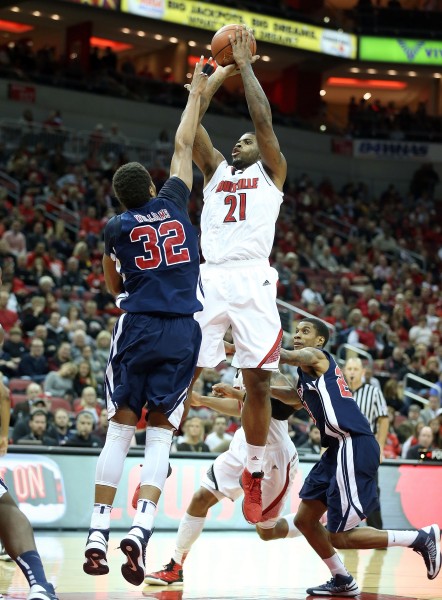Can Louisville Adapt to a Life Without Threes?
Posted by Will Tucker on November 15th, 2012Will Tucker is an RTC correspondent and a Big East microsite writer. He filed this report after Thursday night’s Louisville-Samford game.
Louisville overwhelmed Samford in all facets of the game tonight, 80-54, to advance to 2-0 and defend their #2 ranking. The box score and postgame highlights will depict a dominant display befitting of an elite team, replete with a 53-28 rebounding margin, a punishing 38 points in the paint, and numerically terrifying double-doubles from Chane Behanan and Gorgui Dieng. But any Louisville fan that watched the game and knows a lick about basketball (read: almost all of them) will temper the glowing conclusions you’d reach from a brief recap. Their team shot 1-8 from three in the first half, but elected to judiciously move the ball into the paint more often than jack up threes. When Samford finally packed the paint with a zone defense and served up wide open looks from beyond the arc in the second half, the Cards took the bait and went 6-23, finishing at a 23% that elicited increasingly frustrated collective groans from the 20,016 on hand at the KFC Yum! Center with each successive brick.
Despite all the things this Louisville team does well (and several things they already do great), their first two games of the 2012-13 season have exposed just how badly they lack a reliable three-point threat. Tonight’s contest refuted any notion that this Louisville team may achieve even average outside shooting. Rick Pitino had displayed uncharacteristic concern over his wings’ jump shots in his postgame press conference last Sunday, after former McDonald’s All-American Wayne Blackshear and transfer Luke Hancock combined to shoot 3-14 from beyond the arc against Manhattan. Tonight, they delivered a dismal 2-18 (11%) performance from outside, while streaky shooter Russ Smith (4-7 3FG) was the only one who salvaged Louisville’s team stat of 7-31 from long range. Blackshear and Hancock, both billed as capable jump shooters, have looked noticeably frustrated in the first two games of the year. Pitino tonight related Hancock to a hitter in a slump, forcing his shot in a fruitless effort “to make contact.” Blackshear, for his part, seems headed in the right direction, appearing much more assertive and confident as he built a somewhat inefficient stat line of 13 points and five rebounds tonight.
Will either Blackshear or Hancock step up and demonstrate a consistent ability to keep defenses honest from outside? Pitino seems to have more confidence in Blackshear for the time being, telling the press after that game that he planned to start Blackshear at the small forward position, along with Russ Smith and Peyton Siva in the backcourt, in the upcoming hypercompetitive Battle For Atlantis tournament. Nevertheless, he admitted Blackshear’s shooting mechanics have regressed since last season’s Final Four.
While Pitino waits on his wings to find some semblance of a stroke, his team will need to focus on its offensive strengths and capitalize on Russ Smith’s erratic productivity. When Peyton Siva manages the half court offense with patience and discipline, he finds vulnerabilities in the zone to exploit: alley-oops, open layups and uncontested mid-range shots at times all presented themselves tonight as Siva slashed through the defense. Furthermore, Wayne Blackshear and Kevin Ware are natural slashers, who are better served drawing contact and collapsing defenses than spotting up around the three-point line.
But lost in all of this anxiety over Louisville’s guards is the neglect of arguably Louisville’s most talented asset: their frontcourt tandem of Dieng and Behanan. Behanan’s had little help from anyone but Siva in building his stat lines through the first two games. Tonight the only way he could get a touch on offense was by cleaning up his guards’ missed jump shots (nine of his 18 rebounds were offensive). For his part, Dieng has become more assertive this season in demanding the ball in the high post, a trend that must continue if Louisville wants to produce any points in the halfcourt. Pitino drew an analogy last Sunday between the Senegalese junior and former point-center David Padgett. Indeed in Dieng, Pitino has a center with a keen intellect and intuitive grasp of the game that hasn’t graced Louisville’s high post since Padgett graduated in 2008. The silky elbow jumper and nuanced touch passes he’s threaded through defenses in these first two outings make Dieng the perfect candidate for a zone-busting weapon, as the Cardinals prepare for the dense zone defenses opponents will inevitably continue to throw at them.
This critique of Louisville’s three-point offense is in no way an indictment of their legitimacy as a title contender. Indeed, the fact that Louisville can dominate in spite of such dismal shooting is indicative of how talented, dynamic and well coached they are. Past performance dictates that Louisville’s guards will eventually overcome their slump, although they may never shoot from outside with impressive efficiency. If Louisville can learn to develop their other offensive assets while they wait for their shooting to improve, it will ultimately benefit the team once they encounter the inevitable poor-shooting night against elite zone defenses later in the season.













































[…] – With so much size in the frontcourt, Louisville is going to have to get away from being a perimeter-oriented team (Rush The Court) […]